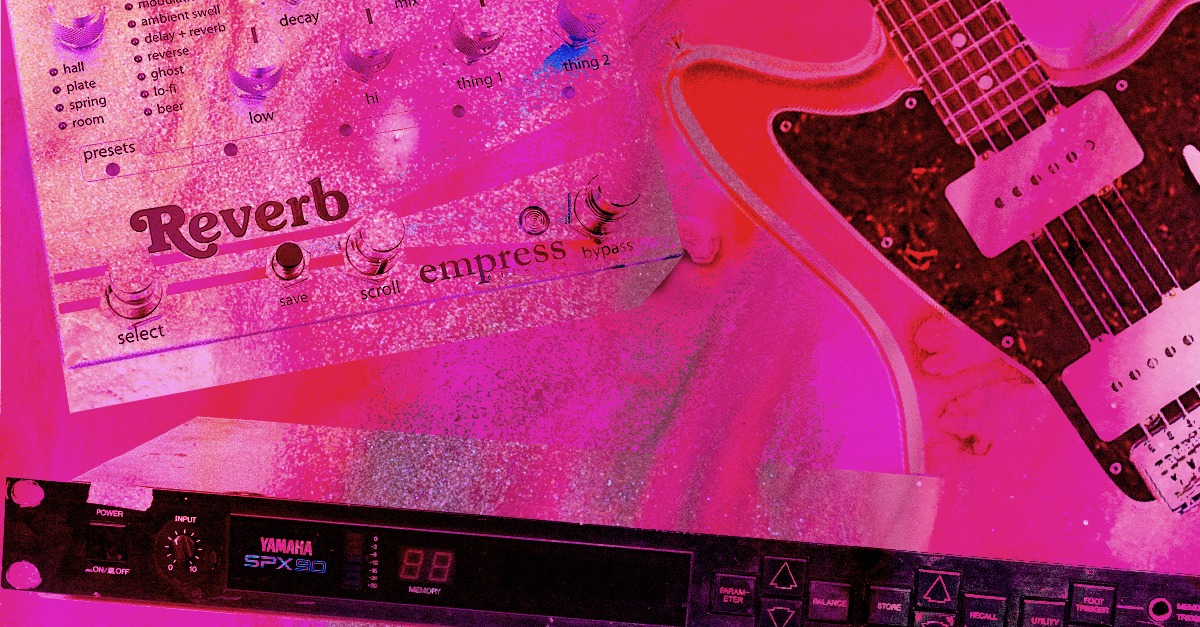
Reverse Reverb: 4 Ways to Create Backwards Ambience

Audio effects are one of the most inspiring ways to manipulate sound.
From basic mixing tools to creative effects, there’s so much you can to make your sound your own.
Ambience processors like delays and reverbs are especially important, and there are countless ways to approach using each.
One of the most striking is called reverse reverb.
The reverse reverb technique is music production technique that will help you present your music in fascinating ways.
In this guide, I’ll break down what reverse reverb is and will show you where to use it in your music. And if you’re looking for reverse reverb plugins, I’ll recommend the best options.
What is reverse reverb?
Reverse reverb is a reverb-effected audio signal that’s played backwards. When you add the reverse reverb effect over the original recording, it creates a unique, otherworldly sound. This production technique can easily be done through most DAWs, but you can also create it through effects processors.
Once you know what to listen for, you’ll hear the reverse reverb effect all over popular music.
This effect adds a distinct layer of ambience to vocals, guitars, synths, and other instruments.
Though it’s currently a production trend in EDM, reverse reverb was pioneered in the 60s by Curt Boettcher and Jimmy Page.
Where can you use reverse reverb?
Reverse reverb can be used all over your tracks. From live drum kits to synths, this technique adds a distinct effect to tracks that sounds completely different than other effects.
Applied to vocals, this technique creates a surreal effect generated from the delivery of the dry vocal and the sucked-in reverb.
Reverse reverb is a classic production concept in the guitar-driven world of shoegaze music. Used alone or in combination with other effects, this technique adds fascinating layers of sound to guitars:
When you add the reverse reverb effect over the original recording, it creates a unique, otherworldly sound
The effect you’ll get using pianos and synths with reverse reverb is a dense swelling sound:
These are just a few examples, but the truth is that this technique can be applied anywhere in your songs where ambience is needed.
You can use it on individual tracks and stems, or even over entire songs if you’re feeling ambitious.
4 Ways to create the reverse reverb effect
There are multiple ways to create the reverse reverb effect, from effects pedal combinations to manually generating it in your DAW.
While there are plenty of ways to mimic this effect, note that adding reverb to a recording, reversing it, and adding it back onto an original dry recording is technically the only way to produce it.
However, this doesn’t mean there aren’t huge advantages to recreating the effect through plugins, pedals, and other methods.
1. Plugins
Plugins like Eventide Reverse Reverb are completely devoted to producing the layered reverse reverb effect. They not only make it easy to add in this sound, but also let you shape the effect with controls.
You can also create the effect through other plugins, like Logic’s Space Designer. This is done by reversing the IR of its convolution reverb. The Valhalla DSP Ubermod and Shimmer plugins also have some reverse settings worth exploring.
Hot tip: Whether you’re looking for stylish effects, inspiring instruments or helpful utilities, there’s a growing library of free and pro plugins over at LANDR Plugins
2. Effects pedals
This is an easy and exciting way to authentically create the reverse reverb effect that lets you shape sounds as you play. While effects pedals are generally used for guitars, you can apply them to vocals and any other melodic instrument.
Reverse reverb is a classic production concept in the guitar-driven world of shoegaze music.
There are different ways to approach creating this effect with pedals, and musicians often throw in delays, distortions, and other sounds into the mix.
You’ll need a loop, reverse, and reverb pedal at the very least. Note that higher-end reverb pedals often come with reverse effects.
3. Rack units
Nonlinear pseudo-reverse settings are included in rack units like Yamaha’s SPX90. They make producing the reverse reverb effect easy and allow for customization.
4. Manually through a DAW
Creating the effect through your DAW isn’t quick or flashy, but it gets the job done. Plus, it’s a way to authentically create this unforgettable sound.
To do this, you’ll start with a dry recording. Then, copy and paste that recording and add it to a separate track. Add reverb to the copied recording, and then reverse it.
When you layer the altered version over the original dry recording, you’ll get reverse reverb. There are lots of tips and tricks for perfecting the manual method, but this is the core of what you’ll need to do.
Put it in reverse
Whether you manually create this sound through your DAW or mimic it with plugins, it’s a great way to add hazy and distinct sounds to your music.
Try reverse reverb the next time you need a haunting, unique ambience effect in your music.
Gear guides, tips, tutorials, inspiration and more—delivered weekly.
Keep up with the LANDR Blog.


